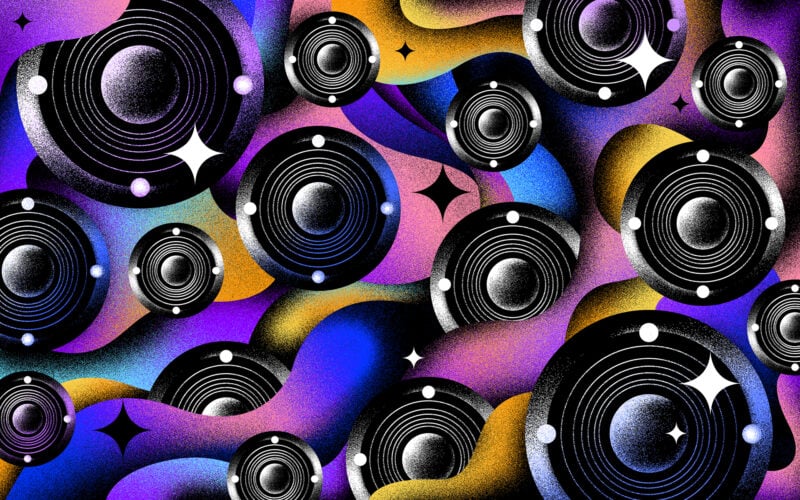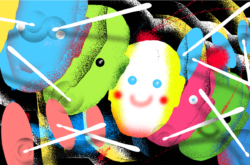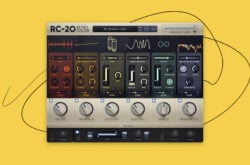Illustration: Jordan Moss
There’s a one-of-a-kind satisfaction that comes with the warmth and crackle of lo-fi music.
While we’ve chased higher and higher fidelity audio over the decades—progressing from reel-to-reel recording and phonographs all the way to lossless digital audio and pristine studio monitors—many of us are now finding ourselves willingly heading in the opposite direction, going out of our way to add some noise and wobble to our audio. What is it that just makes lo-fi music so appealing?
In this article, we examine the style’s key characteristics, break down why they’re effective, and explore how to make lo-fi music of our own. Feel free to use the table of contents below to easily jump to a specific section.
What you’ll learn:
Feeling ready? Let’s get started!
What is lo-fi music?
Lo-fi (also commonly stylized as ‘lofi’ and ‘LoFi’) is short for “low fidelity.” Broadly speaking, the term describes content that’s not captured with the highest degree of exactness. In the world of music, this translates to audio that has perceptible ‘imperfections’—these can range from the crackle of a dusty vinyl record to the crunch of low bitrates in the digital realm.
In many traditional contexts, we would attempt to eliminate these imperfections in pursuit of the cleanest recording possible. However, lo-fi music not only forgoes doing this, but embraces the imperfections as positive qualities. While the sheen of modern digital recordings is nice and all, there’s indeed an undeniable nostalgia to the so-called flaws of lo-fi—perhaps the vinyl crackle reminds you of your grandfather’s old record player, or bitcrushing evokes fond memories of your favorite childhood video games.
And even if these things weren’t a part of your past, many simply find the warmer, minimalistic sound that defines lo-fi music calming and comforting. YouTube radio channels like Lofi Girl show us that literally millions of people enjoy relaxing and studying to lo-fi beats every day.
The characteristics of lo-fi tracks
We’ve started touching on them a bit above, but what exactly are the characteristics of lo-fi music? While every track won’t contain all of these qualities, we break down some popular patterns below, categorized into timbre and theory.
Timbre:
- Sounds that emulate older recording and playback systems: These might include tape hiss, crackle, hum, wobble, etc.
- Background noise: Elements like distant conversation or the faint soundscape of a city bleeding in through a window can help achieve a feeling of immersion.
- Saturation: Also a staple of older recordings, some gentle tape saturation can help introduce that signature ‘warmth.’
- ‘Reduced’ audio quality: This can take shape in many forms—perhaps the bitrate is reduced, or some highs are simply rolled off with an EQ.
Theory:
- Colorful chords: Particularly in the realms of lo-fi hip hop, chill hop, and jazz hop, seventh chords and other extensions are very common.
- Loops: Since a lot of modern lo-fi music is intended to be relaxing or atmospheric, it often features looping beats and progressions; for this reason, sampling is also a key technique within the style.
- Humanization: The emphasis on imperfection extends beyond timbre—rhythms will often avoid quantization or extreme precision, instead freely remaining off the grid.
- Simple arrangements: Most lo-fi tracks aren’t super busy when it comes to arrangement—a modest acoustic kit, some keys, and a bassline can be perfectly sufficient.
- Slower BPMs: Lo-fi beats in particular tend to lean towards gentler tempos—somewhere in the range of 60 – 90 BPM could be a good starting point.
None of these are hard rules or requisites to making lo-fi tracks. However, if you’re not sure where to start, they’re absolutely worth exploring.
How to make lo-fi music
We now have an idea of what lo-fi music is and what its defining features are. So, how do we go about bringing our own ideas to life in the DAW?
Funnily enough, many of the ‘imperfect’ tools that define the style’s sound (like classic recording devices and worn-out vintage keyboards) are now ridiculously expensive. Therefore, many of us will largely be achieving the lo-fi sound by taking our modern, polished sounds and intentionally wearing them down. It’s kind of like taking a pair of new jeans and adding tears and scratches to them in pursuit of a certain aesthetic.
Below, we showcase some tools and techniques that will be particularly helpful in this endeavor.
Tools for making lo-fi music
Many of the timbral qualities we mentioned above can be achieved with the native effects plugins that come right within your DAW. You may even have a lot of luck on the software instruments side, since you’ll generally be looking for simple, versatile sounds as opposed to mind-blowing arpeggiators or piercing leads. That said, there are also some specialized tools that allow for more nuanced control and sound design options if you want to take things further.
For example, one plugin that simply can’t be omitted from any discussion of lo-fi music is XLN Audio’s RC-20 Retro Color. Featuring dedicated noise, wobble, digital, magnetic, and distortion modules, the plugin is perfect for replicating the sound of vintage recording equipment (for a fraction of the cost).
Arturia’s V Collection could also be worth checking out for high-quality emulations of classic keys and synths that fit right into the lo-fi palette. And if you’re looking for loops, there are countless sample packs available that feature sounds that are specifically geared towards the lo-fi sound and its many associated genres.
Techniques for making lo-fi music
While we’ve been exploring the large umbrella of lo-fi music, the techniques you’ll be employing in practice will vary based on the more nuanced sound you’re going for. With that in mind, below are two ten-minute tutorials where we dive into some of these distinctions, walking through how you might approach making a lo-fi hip hop beat vs. a lo-fi house track.
Last but not least, if you’d like to go under the hood and design your own instruments from scratch, join us in the tutorial below where we use stock Ableton plugins to design our own lo-fi piano from scratch.
Conclusion
From our mixes to our social media presence, many of us are used to feeling like everything that revolves around our artistry needs to be perfect. Lo-fi music tells us that this doesn’t have to be the case—that we can embrace quirks and imperfections and still come out with something great.
For this reason, learning how to make lo-fi music can be not only highly enjoyable but quite liberating. Hopefully this article equipped you with the insights and tools you need to get started on your journey.
Do you have any questions on how to make lo-fi music that we didn’t cover above? What sorts of topics would you like to see us explore next? Start a conversation with us on the Splice Discord.
Create a lo-fi beat for free with Create mode:
April 2, 2024



